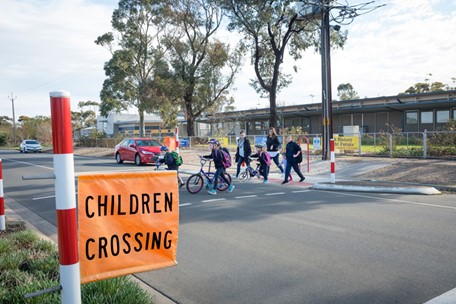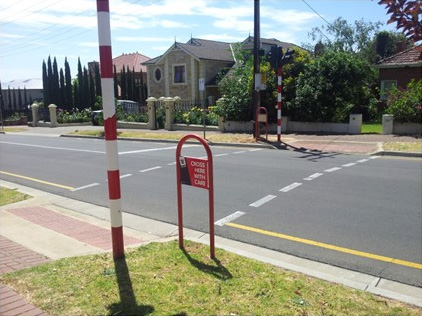Safety around Schools
Schools and local community places tend to have the highest concentration of children and are heavily congested with traffic during peak times. Everyone is responsible for keeping students safe when they travel to and from school.
Schools in South Australia are on roads maintained by local or state government. The Department of Infrastructure and Transport works with councils, schools and other stakeholders to identify, plan, design and implement safety improvements so that our local streets are:
- safer for everyone who uses them
- easier for everyone to get around.
School zones and crossings make it safer for students on their way to and from school. Other treatments such as improved pedestrian ramps and educational signage also help.
School zones

In South Australia, school zones apply 24 hours a day, 7 days a week throughout the year. White zigzag lines are marked on the road, showing you are approaching a school zone. Signs show the start and end of school zones.
School zones have a speed limit of 25km/h whenever a child is in the zone or on the road, footpath or median strip – even if they are on a bike or scooter. A child is any person less than 18 years of age or a student of any age wearing a school uniform.
When pedestrians cross the road in a school zone, they should use the STOP LOOK LISTEN THINK procedure.
Signs and restrictions around schools
Drivers must not stop at any time for any reason in an area marked 'no stopping' or 'no standing'.
Drivers must not stop in a 'no parking' zone unless they are immediately picking up or dropping off passengers. Drivers must remain with their vehicle and can only be in the zone for 2 minutes or less.
Some schools have drop off and pick up (kiss n drop, pick up/drop off) zones. Some are situated on roads outside the school and others are within school grounds. Check with your child’s school for any rules that apply when using these zones. Be mindful that congestion in these zones increases the risk for children.
All road users travelling in either direction must not exceed 25km/h when passing a school bus that has stopped to set down or pick up children.
School crossings
Crossings near schools are for students and their families to travel to and from school safely. Learn about each crossing type below and how they operate. Watch South Australian Police's video to learn about being safe at school crossings.
Emu crossings

Emu crossings have white road markings and red "CHILDREN CROSSING" flags displayed on red and white posts. They are located in school zones. Emu crossings are part-time crossings and are operational when the 'children crossing' flags are displayed.
Flags are displayed during main crossing times, such as 30 minutes before school starts, 30 minutes after school ends and during lunchtime. Flags should be taken down at the end of each crossing period. Schools may provide school crossing monitors to supervise the crossing of children and adults.
Pedestrians (and anyone wanting to use the crossing) should:
- follow the instructions of Crossing Monitors if they are in use
- use the 'Stop. Look. Listen Think.' procedure to check that vehicles have stopped and drivers have seen them before they walk or ride across
- remember when the flags are not up, pedestrians, bicycle and scooter riders do not have priority to cross.
Drivers, motorcycle and bicycle riders on the road must:
- travel at no more than 25km/h at any time when children are present on the road or footpath
- stop for anyone using the crossing or about to use the crossing when flags are displayed
- not park within 20 metres of the approach to an emu crossing or within 10 metres after passing it.
Koala crossings

Koala crossings have white road markings and twin alternating flashing yellow lights on red and white posts. Koala crossings are part-time crossings. They are only operational when the yellow lights are flashing. Schools may provide school crossing monitors to supervise the crossing of children and adults.
Pedestrians (and anyone wanting to use the crossing) should:
- follow the instructions of Crossing Monitors if they are in use
- use the STOP LOOK LISTEN THINK procedure (even when the lights are flashing) to check that vehicles have stopped and drivers have seen them before they walk or ride across
- remember when the lights are not flashing that pedestrians, bicycle and scooter riders do not have priority to cross.
Drivers, motorcycle and bicycle riders on the road must:
- remember that a speed limit of no more than 25km/h applies between the signs that state 'when lights flashing'
- stop for anyone using the crossing or about to use the crossing when the lights are flashing
- not park within 20 metres of the approach to a koala crossing or within 10 metres after passing it.
Pedestrian actuated crossings

Pedestrian actuated crossings have white road markings and are controlled by traffic lights. Large round metal push buttons are located on both sides of the crossing. Push button crossings operate 24 hours a day, 7 days a week throughout the year. Schools may provide school crossing monitors to supervise the crossing of children and adults.
Pedestrians (and anyone wanting to use the crossing) should:
- follow the instructions of Crossing Monitors if they are in use
- use the 'Stop. Look. Listen. Think' procedure:
- Stop – push the button and wait back from the kerb
- Look – right to check that the drivers have stopped before starting to cross, even when the green WALK signal has appeared
- Listen – slow beep DON’T WALK, fast beep WALK
- Think – walk straight across the road, don’t run.
Drivers, motorcycle and bicycle riders on the road must:
- comply with speed limit of the road and must stop on the red signal
- not park within 20 metres of the approach to a pedestrian crossing or within 10 metres after passing it.
School Crossing Monitors
School crossing monitors play an important part in road safety and are responsible for:
- giving reasonable directions to pedestrian and safe efficient movement of people and traffic
- exhibiting stop signs and/or flags requiring road users to stop before driving over a school crossing.
Monitors are legally required to be at least 10 years of age and be trained and authorised by South Australia Police.
Schools can book training sessions or find out more information by contacting South Australia Police by phone ;8207 6923 or email SAPOL.RoadSafetySection@police.sa.gov.au.
Road safety education in schools
Please visit the Safe People section for road safety education for schools.

